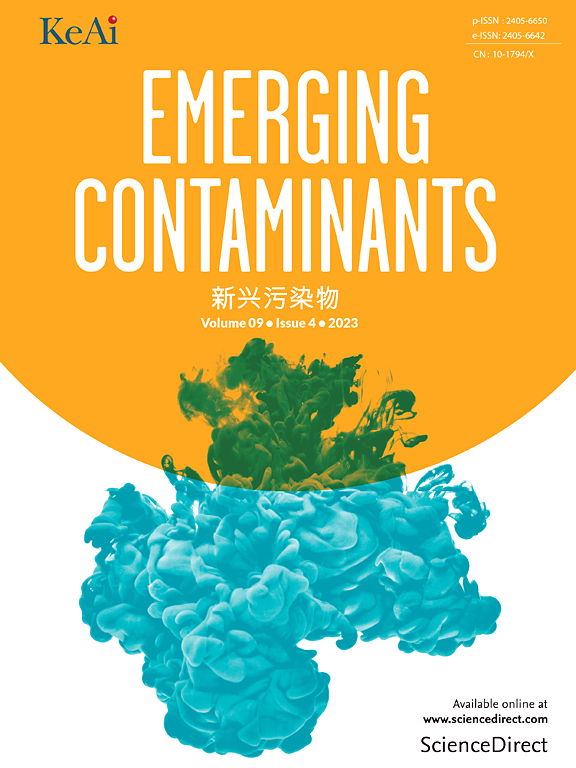Persistent and emerging brominated flame retardants in indoor dust and human hair from remote agro-pastoral areas of Inner Mongolia: Pollution characteristics, source apportionment, and human exposure
IF 6.9
2区 环境科学与生态学
Q1 ENVIRONMENTAL SCIENCES
引用次数: 0
Abstract
The widespread use of brominated flame retardants (BFRs), including polybrominated diphenyl ethers (PBDEs) and novel brominated flame retardants (NBFRs), poses significant environmental and health risks, yet data on their contamination in remote agro-pastoral regions remain scarce. This study systematically investigated the pollution characteristics, sources, and human exposure risks of PBDEs and NBFRs in indoor dust and human hair from 11 households in Inner Mongolian grasslands. Results revealed that PBDEs were ubiquitous in all dust samples (median ∑10PBDEs: 15.8 ng/g dw, with a 95 % confidence interval of 2.88–48.1 ng/g dw), dominated by BDE-209 (73.6–100 %), reflecting legacy Deca-BDE usage despite regulatory restrictions. NBFRs (median ∑NBFRs: 0.77 ng/g dw, 95 % CI: 0.42–1.14 ng/g dw) in dust were predominated by hexabromobenzene (HBB, 41.7 %) and pentabromobenzylacrylate (PBBA, 18.8 %). In human hair, PBDEs (median ∑10PBDEs: 6.77 ng/g dw, 95 % CI: 2.31–52 ng/g dw) showed comparable levels to urban populations, with BDE-209 contributing 71.7–99.7 %, while NBFRs (median ∑NBFRs: 0.64 ng/g dw, 95 % CI: 0.23–1.97) mirrored dust profiles (HBB: 43.4 %), suggesting dust as a likely exposure route (r = 0.575–0.699, p < 0.05). Source analysis identified Penta-/Octa-BDE degradation and industrial applications (plastics/textiles for tetrabromo-p-xylene (pTBX)-pentabromobenzene (PBBz)-pentabromotoluene (PBT); electronics for PBBA-HBB) as key contributors. Human age-dependent accumulation patterns was observed, with higher PBDEs in the elderly and increasing PBBz/PBT levels with age (r = 0.528–0.564, p < 0.05). Despite lower dust contamination than urban areas, hair-based exposure highlighted non-dust pathways (e.g., air inhalation) for low-brominated congeners. These findings underscore the persistent risks of legacy PBDEs and emerging NBFRs in remote regions, advocating for stricter lifecycle management of BFR-containing products and long-term health monitoring.
内蒙古偏远农牧区室内粉尘和人发中持久性和新出现的溴化阻燃剂:污染特征、来源分配和人类暴露
广泛使用的溴化阻燃剂,包括多溴联苯醚(PBDEs)和新型溴化阻燃剂(NBFRs),造成了重大的环境和健康风险,但关于其在偏远农牧区污染的数据仍然很少。本研究系统调查了内蒙古草原11户家庭室内粉尘和人发中多溴二苯醚和NBFRs的污染特征、来源及人体暴露风险。结果表明,所有粉尘样品中普遍存在多溴二苯醚(∑10PBDEs的中位数:15.8 ng/g dw, 95%置信区间为2.88 ~ 48.1 ng/g dw),其中以BDE-209居多(73.6 ~ 100%),反映了尽管有法规限制,但十溴二苯醚的使用仍然存在。粉尘中NBFRs(中位数∑NBFRs: 0.77 ng/g dw, 95% CI: 0.42 ~ 1.14 ng/g dw)以六溴苯(HBB, 41.7%)和五溴甲基丙烯酸甲酯(PBBA, 18.8%)为主。在人类头发中,多溴联苯醚(∑10PBDEs中位数:6.77 ng/g dw, 95% CI: 2.31 ~ 52 ng/g dw)的水平与城市人群相当,其中BDE-209贡献了71.75 ~ 99.7%,而NBFRs(∑NBFRs中位数:0.64 ng/g dw, 95% CI: 0.23 ~ 1.97)反映了粉尘分布(HBB: 43.4%),表明粉尘是可能的暴露途径(r = 0.575 ~ 0.699, p < 0.05)。来源分析确定了五溴二苯醚/八溴二苯醚降解和工业应用(塑料/纺织品)中的四溴对二甲苯(pTBX)-五溴苯(PBBz)-五溴甲苯(PBT);PBBA-HBB的电子器件是主要贡献者。观察到人类年龄依赖的累积模式,多溴二苯醚在老年人中较高,PBBz/PBT水平随年龄增长而增加(r = 0.528-0.564, p < 0.05)。尽管粉尘污染低于城市地区,但毛发暴露突出了低溴同系物的非粉尘途径(例如空气吸入)。这些发现强调了偏远地区遗留多溴二苯醚和新出现的nbfr的持续风险,提倡对含bfr的产品进行更严格的生命周期管理和长期健康监测。
本文章由计算机程序翻译,如有差异,请以英文原文为准。
求助全文
约1分钟内获得全文
求助全文
来源期刊

Emerging Contaminants
Medicine-Public Health, Environmental and Occupational Health
CiteScore
10.00
自引率
6.70%
发文量
35
审稿时长
44 days
期刊介绍:
Emerging Contaminants is an outlet for world-leading research addressing problems associated with environmental contamination caused by emerging contaminants and their solutions. Emerging contaminants are defined as chemicals that are not currently (or have been only recently) regulated and about which there exist concerns regarding their impact on human or ecological health. Examples of emerging contaminants include disinfection by-products, pharmaceutical and personal care products, persistent organic chemicals, and mercury etc. as well as their degradation products. We encourage papers addressing science that facilitates greater understanding of the nature, extent, and impacts of the presence of emerging contaminants in the environment; technology that exploits original principles to reduce and control their environmental presence; as well as the development, implementation and efficacy of national and international policies to protect human health and the environment from emerging contaminants.
 求助内容:
求助内容: 应助结果提醒方式:
应助结果提醒方式:


